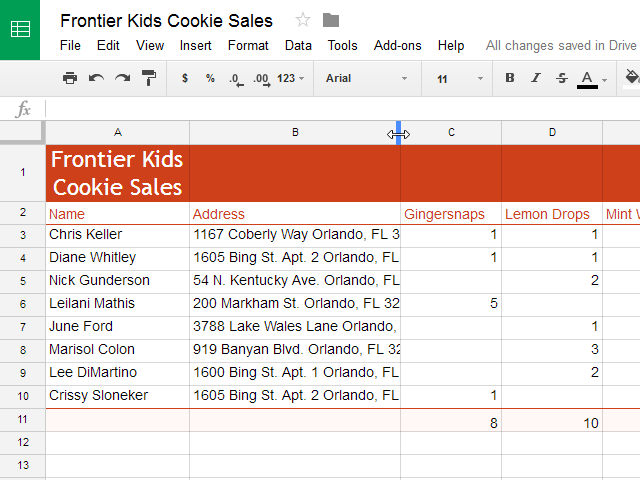
Introduction
Google Sheets, a powerful spreadsheet tool within the Google Workspace suite, offers users the capability to organize and manipulate data efficiently. The ability to modify columns, rows, and cells lies at the core of spreadsheet proficiency, enabling users to structure, analyze, and visualize data with precision. This comprehensive guide will delve into the intricacies of modifying columns, rows, and cells in Google Sheets, empowering users with a deep understanding of the tools and techniques that elevate data manipulation to an art form.
Section 1: The Basics of Google Sheets
1.1 Overview of Google Sheets
Google Sheets is a cloud-based spreadsheet application that allows users to create, edit, and collaborate on spreadsheets online. It offers a range of features for data organization, analysis, and visualization.
1.2 Navigating the Google Sheets Interface
- Menu Bar: Contains various menus for formatting, data manipulation, and more.
- Toolbar: Provides quick access to commonly used tools.
- Spreadsheet Grid: Comprises rows and columns where data is entered and manipulated.
- Sheets: Multiple sheets can be added to a spreadsheet, each residing on its own tab at the bottom.
Section 2: Modifying Columns, Rows, and Cells
2.1 Modifying Columns
2.1.1 Adjusting Column Width
- Hover over the column header.
- Click and drag to adjust the width.
2.1.2 Inserting Columns
- Right-click on the column header.
- Select “Insert 1 above” or “Insert 1 below.”
2.1.3 Deleting Columns
- Right-click on the column header.
- Select “Delete column.”
2.2 Modifying Rows
2.2.1 Adjusting Row Height
- Hover over the row header.
- Click and drag to adjust the height.
2.2.2 Inserting Rows
- Right-click on the row header.
- Select “Insert 1 above” or “Insert 1 below.”
2.2.3 Deleting Rows
- Right-click on the row header.
- Select “Delete row.”
2.3 Modifying Cells
2.3.1 Entering Data
- Click on a cell.
- Enter data.
- Press “Enter” to move to the next cell.
2.3.2 Formatting Cells
- Select the cells you want to format.
- Use the toolbar to apply formatting options such as font style, size, and color.
2.3.3 Merging Cells
- Select the cells to merge.
- Click on the “Merge” button in the toolbar.
2.3.4 Splitting Cells
- Select the merged cell.
- Click on the “Split” button in the toolbar.
Section 3: Advanced Techniques for Data Manipulation
3.1 Using Formulas
3.1.1 Basic Formulas
- Click on a cell.
- Type “=” to start a formula.
- Enter the formula (e.g., =SUM(A1:B2)).
- Press “Enter.”
3.1.2 Using Functions
Explore a variety of functions to perform complex calculations:
- SUM: Adds up a range of numbers.
- AVERAGE: Calculates the average of a range.
- VLOOKUP: Searches for a value in a table and returns a corresponding value.
3.2 Data Validation
Ensure data accuracy by setting up data validation rules:
- Select the cells to validate.
- Go to “Data” > “Data validation.”
- Set criteria for valid data.
3.3 Conditional Formatting
Highlight data based on specified conditions:
- Select the cells.
- Go to “Format” > “Conditional formatting.”
- Set rules for formatting.
3.4 Sorting and Filtering Data
3.4.1 Sorting Data
- Select the range of cells to sort.
- Go to “Data” > “Sort range.”
- Choose sorting options.
3.4.2 Filtering Data
- Select the range of cells.
- Go to “Data” > “Create a filter.”
- Use filter options in the column headers.
Section 4: Collaborative Editing in Google Sheets
4.1 Sharing and Permissions
Collaborate with others by sharing your spreadsheet:
- Click on the “Share” button in the top-right corner.
- Enter email addresses or shareable link.
- Set permission levels (Viewer, Commenter, or Editor).
4.2 Commenting and Discussions
Facilitate discussions with comments:
- Highlight the cell.
- Right-click and choose “Comment.”
- Collaborators can leave comments and replies.
4.3 Real-Time Editing
Collaborate in real-time with multiple users:
- Share the spreadsheet.
- Collaborators can edit simultaneously.
4.4 Version History
Review and revert to previous versions of the spreadsheet:
- Go to “File” > “Version history” > “See version history.”
- View and restore previous versions.
Section 5: Additional Tips and Tricks
5.1 Keyboard Shortcuts
Efficiently navigate and perform actions with keyboard shortcuts:
- Ctrl + C / Cmd + C: Copy.
- Ctrl + V / Cmd + V: Paste.
- Ctrl + Z / Cmd + Z: Undo.
5.2 Using Add-Ons
Explore Google Sheets add-ons for additional functionality:
- Go to “Add-ons” in the menu.
- Select “Get add-ons.”
5.3 Google Sheets Mobile App
Extend your productivity to mobile devices:
- Download the Google Sheets app.
- Access and edit spreadsheets on the go.
Conclusion
Mastering the art of modifying columns, rows, and cells in Google Sheets is a fundamental skill for anyone working with data. From basic adjustments to advanced data manipulation techniques, this comprehensive guide has equipped you with the knowledge to navigate the expansive capabilities of Google Sheets. Whether you’re a beginner exploring the basics or an experienced user seeking to enhance your data manipulation skills, the tools and techniques outlined in this guide will empower you to efficiently structure and analyze data with precision. Welcome to the world of dynamic spreadsheet manipulation, where data transforms into actionable insights with every modification.